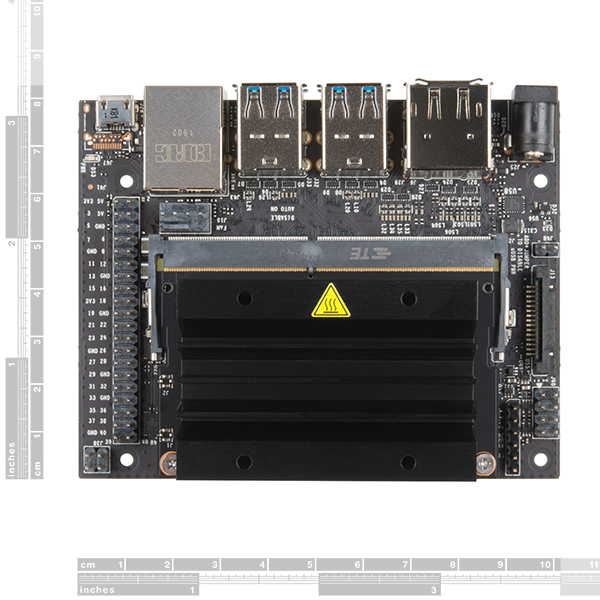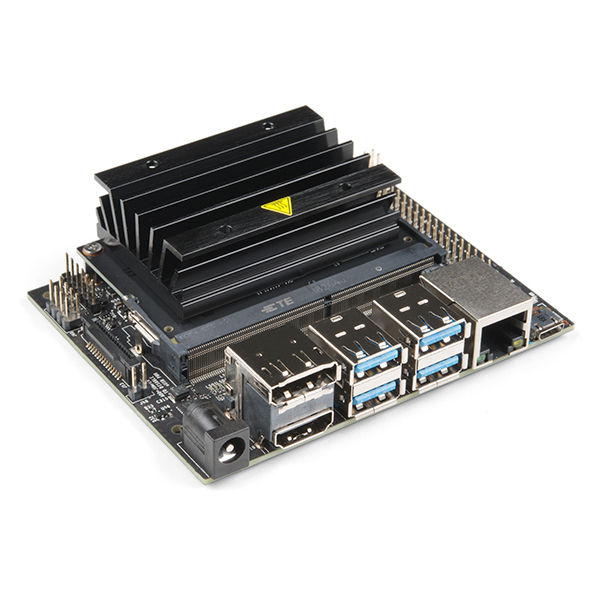×
SparkFun will be closed on Tuesday, December 24th, and Wednesday, December 25th, in observance of the Christmas holiday. Any orders qualifying for same day shipping placed after 2:00 p.m. (MST) on Monday, December 23rd, will be processed on Thursday, December 26th, when we return to regular business hours. Wishing you a safe and happy holiday from all of us at SparkFun!
Please note - we will not be available for Local Pick up orders from December 24th-December 27th. If you place an order for Local Pick-Up we will have those ready on Monday, December 30th.
SparkFun DLI Kit for Jetson Nano
With the release of the Jetson Nano™ Developer Kit, NVIDIA® empowers developers, researchers, students, and hobbyists to explore AI concepts in the most accessible way possible. Reinforcing its commitment to widening the accessibility to and innovation in the area of deep learning, NVIDIA has created a free, self-paced, online Deep Learning Institute (DLI) course, “Getting Started on AI with Jetson Nano.” The goal of the course is to build foundational skills to enable anyone to get creative with the Jetson Developer Kit.
Included in this kit is everything you will need to get started in the “Getting Started on AI with Jetson Nano” and you will learn how to
- Set up your Jetson Nano and camera
- Collect image data for classification models
- Annotate image data for regression models
- Train a neural network on your data to create your own models
- Run inference on the Jetson Nano with the models you create
The NVIDIA Deep Learning Institute offers hands-on training in AI and accelerated computing to solve real-world problems. Developers, data scientists, researchers, and students can get practical experience powered by GPUs in the cloud and earn a certificate of competency to support professional growth. They offer self-paced, online training for individuals, instructor-led workshops for teams, and downloadable course materials for university educators.
Note: Already have a Jetson Nano Developer Kit? You're in luck! We have made an easy to purchase wish list to help get you started with the DLI course.
- NVIDIA Jetson Nano Developer Kit
- 32GB MicroSD card
- Raspberry Pi Camera Module
- Power Supply 5V, 4A
- USB Cable - microB (reversible)
- 2-Pin Jumper
Note Included but Needed for Operation: A computer with an Internet connection and the ability to flash your microSD card.
SparkFun DLI Kit for Jetson Nano Product Help and Resources
Core Skill: Programming
If a board needs code or communicates somehow, you're going to need to know how to program or interface with it. The programming skill is all about communication and code.
Skill Level: Experienced - You will require a firm understanding of programming, the programming toolchain, and may have to make decisions on programming software or language. You may need to decipher a proprietary or specialized communication protocol. A logic analyzer might be necessary.
See all skill levels
Core Skill: Electrical Prototyping
If it requires power, you need to know how much, what all the pins do, and how to hook it up. You may need to reference datasheets, schematics, and know the ins and outs of electronics.
Skill Level: Rookie - You may be required to know a bit more about the component, such as orientation, or how to hook it up, in addition to power requirements. You will need to understand polarized components.
See all skill levels
Comments
Looking for answers to technical questions?
We welcome your comments and suggestions below. However, if you are looking for solutions to technical questions please see our Technical Assistance page.
Customer Reviews
3.7 out of 5
Based on 3 ratings:
Easy to get in the game with this kit
Setup is straight-forward, and the free course included is very educational. I would give it 5 stars, but the method to run the board headless using the remote NDIS connection and included USB cable does not work well. I ended up temporarily connecting a monitor, keyboard and mouse to get the MAC address of the board, then assigned a static DNS address to that. This works much, much better using the JupyterLab interface used for the course, and will save you a lot of frustration. Aside from that, I highly recommend the DLI kit for learning about AI and seeing what the fuss is all about.
I also built a MicroSD card with the normal (not headless) release, and this goes smoothly and works well too.
The included CSI camera works well, and will get you through the course. It is awkward to position though, and it won't be long before you're wanting to use a USB camera with a good mount.
Definitely worth the money, and I am getting a lot out of it.
is good
is good
I still have high hopes...
I bought this and was very excited to give it a try. But after spending an entire day following all the setup screens and installing and updating, I still haven't seen this thing deliver on its promise. Even just getting a very simple demo running is a daunting and exhaustive experience with very little juice for the squeeze. I may be at the precipice of success, but boy it is a lot of work just to get this thing running. Also, the Linux distro runs slower than a RaspberryPi 3.





